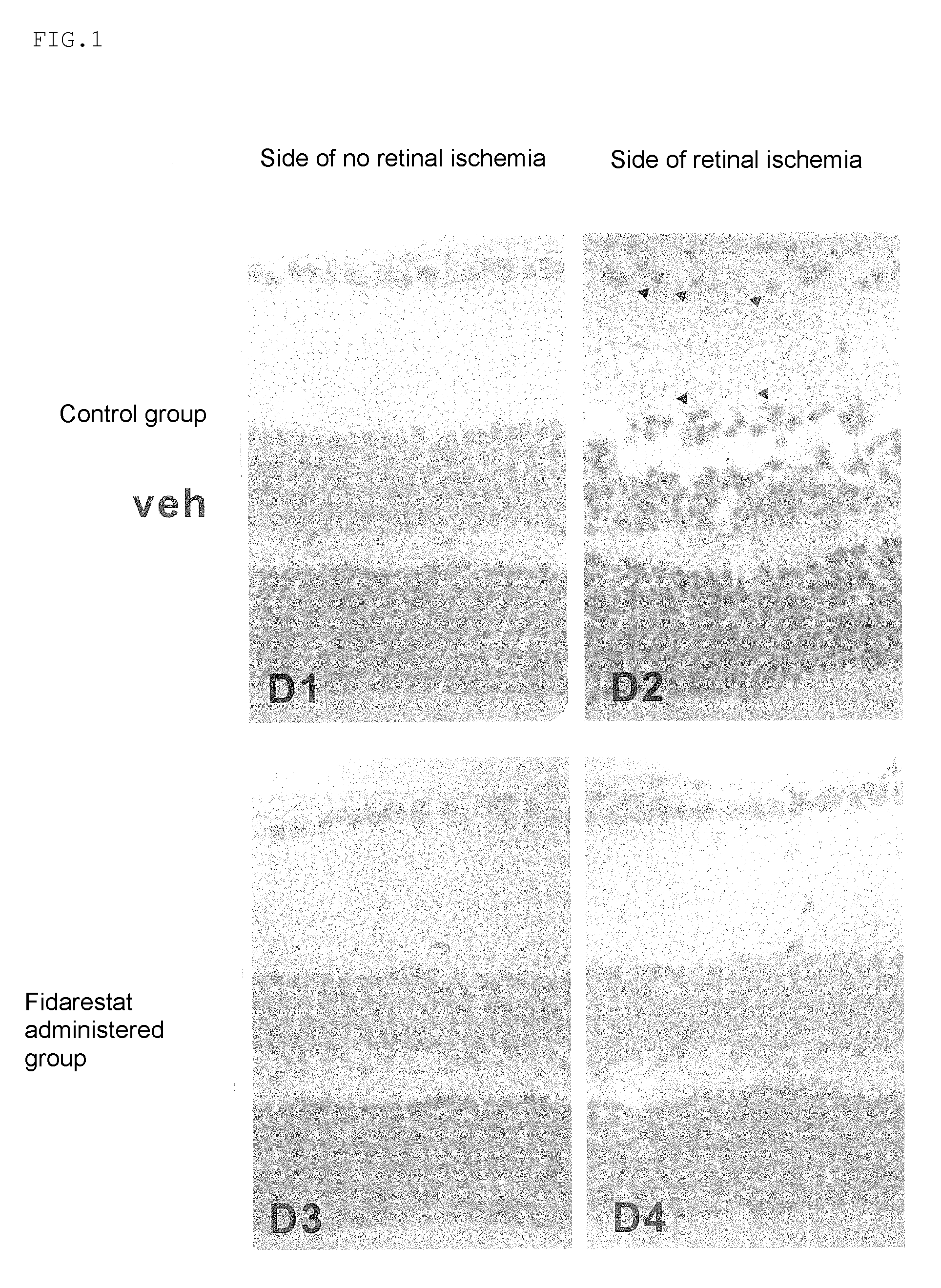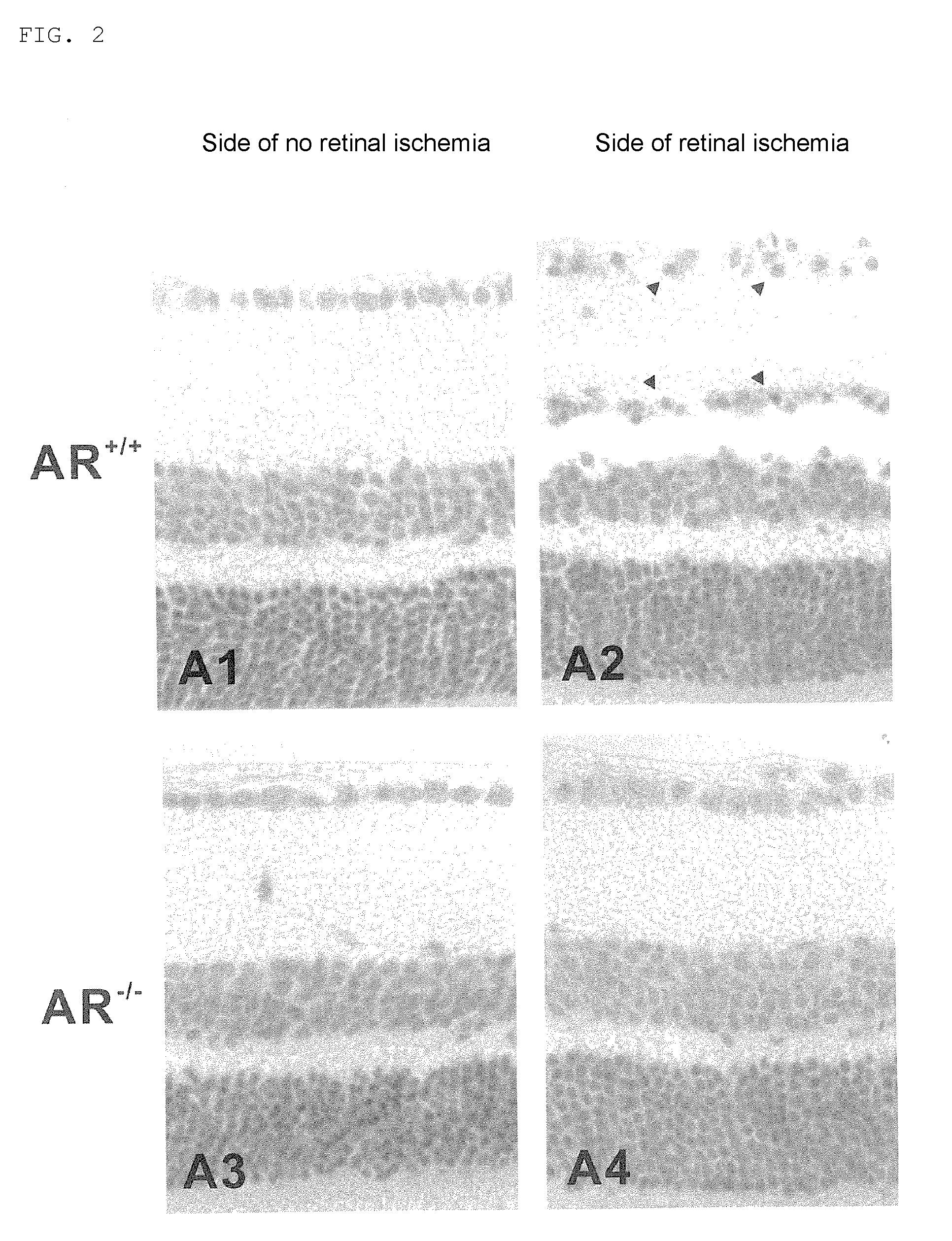Protective agent for retinal nerve or optic nerve
a retinal nerve and optic nerve technology, applied in the direction of biocide, drug composition, cardiovascular disorder, etc., can solve the problems of slow progression, extreme difficulty in restoring lost function, and difficulty in preventing and improving progress
- Summary
- Abstract
- Description
- Claims
- Application Information
AI Technical Summary
Benefits of technology
Problems solved by technology
Method used
Image
Examples
examples
1. Test Method
[0038]In the experiment, mouse models with acute ophthalmic artery infarction, namely, mouse models with ophthalmic artery infarction were used. In Experiment 1, eight to ten-week-old C57BL / 6N normal mice (wild type mice) were used and the therapeutic efficacy of fidarestat as the compound with aldose reductase (AR) inhibiting activity was evaluated. Here, those mice were divided into two groups: a control group to which only vehicle was administered and a fidarestat administered group to which fidarestat was administered. In Experiment 2, eight to ten-week-old C57BL / 6N normal mice (wild type mice:AR+ / + mice) and AR gene-deficient mice (AR− / − mice) were used and the role of AR was examined. Here, those mice were divided into two groups: a wild type mouse group (AR+ / + mice) and an AR gene-deficient mouse group (AR− / − mice) and a drug administered group was not used.
[0039]Used mice (24 to 28 g of body weight) were subjected to intraluminal suture with nylon monofilament ...
experiment 1
[0042]Results are shown in Table 1. The number of surviving retinal ganglion cells present on the side of retinal ischemia in the control group was significantly decreased as compared with that on the side of no retinal ischemia (P<0.001). On the other hand, the number of surviving retinal ganglion cells present on the side of retinal ischemia in the fidarestat administered group was significantly increased as compared with that in the control group (P<0.001). As for the side of no retinal ischemia, difference in the number of surviving retinal ganglion cells in the fidarestat administered group and the control group was not observed.
[0043]
TABLE 1Effect of fidarestat on the number of surviving retinal ganglioncellsSide of no retinalSide of retinalischemiaischemiaControl group24 ± 14 ± 1***Fidarestat administered23 ± 121 ± 1††† groupThe number of surviving retinal ganglion cells per 1 μm of retina section, average ± SEM***P †††P
experiment 2
[0044]Results are shown in Table 2. The number of surviving retinal ganglion cells present on the side of retinal ischemia in the wild type mouse group was significantly decreased as compared with that on the side of no retinal ischemia (P<0.001). On the other hand, the number of surviving retinal ganglion cells present on the side of retinal ischemia in the AR gene-deficient mouse group was significantly increased as compared with that in the wild type mouse group (P<0.001). As for the side of no retinal ischemia, difference in the number of surviving retinal ganglion cells in the wild-type mouse group and the AR gene-deficient mouse group was not observed.
[0045]
TABLE 2Effect of AR gene-deficient mice on the number of survivingretinal ganglion cellsSide of no retinalSide of retinalischemiaischemiaWild-type mice23 ± 13 ± 1***AR gene-deficient mice21 ± 318 ± 2†† The number of surviving retinal ganglion cells per 1 μm of retina section, average ± SEM***P ††P
3. Discussion
[0046]Reti...
PUM
| Property | Measurement | Unit |
|---|---|---|
| body weight | aaaaa | aaaaa |
| intraocular pressure | aaaaa | aaaaa |
| open-angle | aaaaa | aaaaa |
Abstract
Description
Claims
Application Information
 Login to View More
Login to View More - R&D
- Intellectual Property
- Life Sciences
- Materials
- Tech Scout
- Unparalleled Data Quality
- Higher Quality Content
- 60% Fewer Hallucinations
Browse by: Latest US Patents, China's latest patents, Technical Efficacy Thesaurus, Application Domain, Technology Topic, Popular Technical Reports.
© 2025 PatSnap. All rights reserved.Legal|Privacy policy|Modern Slavery Act Transparency Statement|Sitemap|About US| Contact US: help@patsnap.com



